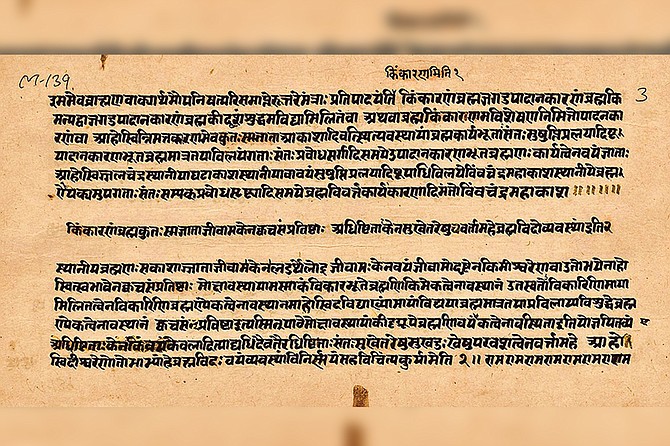 Facebook
Facebook
 X
X
 Instagram
Instagram
 TikTok
TikTok
 Youtube
Youtube

Shvetashvatara Upanishad
In that vast Brahma-wheel, in which all things live and rest, the bird flutters about, so long as he thinks that the self (in him) is different from the mover (the god, the lord). When he has been blessed by him, then he gains immortality. But what is praised (in the Upanishads) is the Highest Brahman, and in it there is the triads. The Highest Brahman is the safe support, it is imperishable. The Brahma-students, when they have known what is within this (world), are devoted and merged in the Brahman, free from birth. The Lord supports all this together, the perishable and the imperishable, the developed and the undeveloped. The (living) self, not being a lord, is bound because he has to enjoy (the fruits of works); but when he has known the god, he is freed from all fetters. There are two, one knowing, the other not-knowing, both unborn, one strong, the other weak; there is she, the unborn, through whom each man receives the recompense of his works; and there is the infinite Self (appearing) under all forms, but himself inactive. When a man finds out these three, that is Brahma. That which is perishable is the Pradhana (the first), the immortal and imperishable is Hara. The one god rules the perishable (the Pradhana) and the (living) self. From meditating on him, from joining him, from becoming one with him there is further cessation of all illusion in the end.
The Shvetashvatara Upanishad is one of the ancient Sanskrit texts held sacred to Hinduism and Buddhism. Dealing in large part with metaphysical concerns, this text asks questions about the primal cause of all existence – its origin and end. It also studies questions about what role, if any, time, nature, necessity, chance, and the spirit had in the work of the primal cause. It concludes that the “Universal Soul” exists in each individual and expresses itself through all of creation, and all objects project its existence. It also sees a unity to existence – a oneness of souls in a single, unique Self.


Shvetashvatara Upanishad
In that vast Brahma-wheel, in which all things live and rest, the bird flutters about, so long as he thinks that the self (in him) is different from the mover (the god, the lord). When he has been blessed by him, then he gains immortality. But what is praised (in the Upanishads) is the Highest Brahman, and in it there is the triads. The Highest Brahman is the safe support, it is imperishable. The Brahma-students, when they have known what is within this (world), are devoted and merged in the Brahman, free from birth. The Lord supports all this together, the perishable and the imperishable, the developed and the undeveloped. The (living) self, not being a lord, is bound because he has to enjoy (the fruits of works); but when he has known the god, he is freed from all fetters. There are two, one knowing, the other not-knowing, both unborn, one strong, the other weak; there is she, the unborn, through whom each man receives the recompense of his works; and there is the infinite Self (appearing) under all forms, but himself inactive. When a man finds out these three, that is Brahma. That which is perishable is the Pradhana (the first), the immortal and imperishable is Hara. The one god rules the perishable (the Pradhana) and the (living) self. From meditating on him, from joining him, from becoming one with him there is further cessation of all illusion in the end.
The Shvetashvatara Upanishad is one of the ancient Sanskrit texts held sacred to Hinduism and Buddhism. Dealing in large part with metaphysical concerns, this text asks questions about the primal cause of all existence – its origin and end. It also studies questions about what role, if any, time, nature, necessity, chance, and the spirit had in the work of the primal cause. It concludes that the “Universal Soul” exists in each individual and expresses itself through all of creation, and all objects project its existence. It also sees a unity to existence – a oneness of souls in a single, unique Self.
Comments